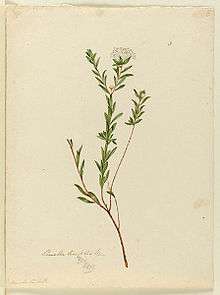Pimelea linifolia
| Pimelea linifolia | |
|---|---|
 | |
| Scientific classification | |
| Kingdom: | Plantae |
| (unranked): | Angiosperms |
| (unranked): | Eudicots |
| (unranked): | Rosids |
| Order: | Malvales |
| Family: | Thymelaeaceae |
| Genus: | Pimelea |
| Species: | P. linifolia |
| Binomial name | |
| Pimelea linifolia Sm. | |
Pimelea linifolia is an Australian shrub, variously known as queen-of-the-bush and the slender or flax-leafed riceflower. It is widespread throughout the south and east of the continent and is toxic to livestock.[1] [2]
The bark can be processed into fine strong thread for catching Agrotis infusa, the Bogong moth. This string, called a 'Bushman's bootlace', is produced by a traditional method that involves wetting, drying, beating and rolling the material.[3]
Description
The plant is prostrate or 1.5 m high. The leaves of the species are narrow or oblanceolate, 2–7 mm, and may be up to 30mm long. Up to 60 white flowers form brachteate heads on glabrous peduncles, bracts are 4 or 8. It was first published in 1793 by James Edward Smith, in his A Specimen of the Botany of New Holland.
Distribution
It is endemic to south-eastern Australia, occurring in South Australia, Victoria, Tasmania, New South Wales and Queensland.
References
| Wikimedia Commons has media related to Pimelea linifolia. |
| Wikisource has original works on the topic: Pimelea linifolia |
- ↑ Harden, G. J. "Pimelea linifolia Sm.". New South Wales Flora Online. PlantNET. Retrieved 2007-07-13.
- ↑ "Australian Plant Common Names Database". Retrieved 2007-07-13.
- ↑ Nash, Daphne. "2. Riceflower Pimelea linifolia". Aboriginal Plant Use in South-Eastern Australia. Australian National Botanic Gardens - Education Service. Retrieved 2007-07-13.
We know the bark of the Riceflower as 'Bushman's Bootlace', but here's how to make string: Strip the bark, dry it, place in a stream for about one week, dry in sun, soften by chewing/beating with sticks and stones, roll on the thigh and spin into fine, strong thread.